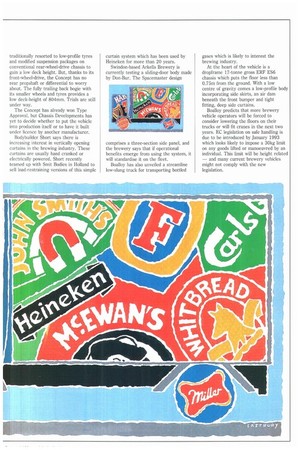PECIF HEIGHTS
Page 30

Page 31

If you've noticed an error in this article please click here to report it so we can fix it.
• The recession has undoubtedly taken its toll on the development of brewery vehicles as transport managers continually try to cut costs. However, some interesting work has been unveiled in the past few months.
The latest announcement comes from MAN, which is launching its own design 19-tonne tri-axle brewery truck on the UK market. The firm is also working with Whitbread on an 11.6-tonne version.
The new UK vehicles from MAN are a development of the fully air suspended 19-tonne version used by Lowenbrau in Germany on urban deliveries. This vehicle started life as a 14-tonne 4x2 with the German brewer.
AIR SUSPENSION
Air suspension is included on the rear bogie with the Whitbread prototype. The front tyres have been increased in size to 17.5in radials but both rear axles are fitted with 16in tyres, and are.plated at 4,000kg each. This gives the vehicle a gross weight of 11.6 tonnes and a payload allowance of six tonnes after fitting a curtainsider body.
The laden floor height mid-wheelbase is under 762mm compared with 890mm on an unmodified vehicle.
MAN says the 19-tonner is now available in the UK. A prototype 11.6-tonner has entered the Whitbread distribution fleet for handling and loading trials_ This is important, says Whitbread fleet engineer Charlie Seeker, as such vehicles require pattern loading to avoid front axle overload.
Whitbread's ultimate target is a vehicle with a platform height of just 712mm with a six-tonne payload and the ability to carry six of its 1,200x1,320mm pallets. It is also developing electronic tagging on its vehicles and trailers.
Secker insists that if the system is used to its full potential Whitbread will be able to reduce the size of its trailer fleet.
Cornish Brewery of St Austell is another innovative operator in this sector. It plans to design a "drayman-friendly" delivery vehicle incorporating an air suspension system capable of lowering the loadbed by up to 100mm. Distribution manager Derek Payne says many draymen suffer medical problems in middle age — probably as a result of years of lifting barrels.
The Cornish vehicle is also likely to be slimmer than traditional brewery vehicles: Payne is hoping for 2.24m instead of the usual 2.5m. It will also use three axles instead of two with a longer body, while retaining a 10-tonne payload capability.
Some work has already been done with Seddon Atkinson, using an extended version of the manufacturer's slirnline municipal chassis fitted with a two-man day cab and air suspension.
Cornish Brewery has also tested Cleenburn, a German system which warms fuel and oil, and found that it `transformed" the performance of a Volkswagen LT35 diesel.
Cleenbum costs around £250 and Cornish Brewery says it improved fuel consumption from 16.61it/100km (17mpg) to 16.114/100km (17.5mpg).
Bass hit the headlines at the end of 1990 with its new front-wheel-drive 6x2 Concept delivery truck, designed jointly with Chassis Developments.
FUTURISTIC RIGID
The futuristic three-axle rigid is powered by a back-to-front-mounted 134kW (180hp) Perkins Phaser engine which turns the front wheels through a ZF WG150 automatic gearbox and GKN-driven steered axle. This driveline sits underneath the same Walter Alexander crew-cab which is fitted on the Britannia Colectomatic dustcart.
Brewery vehicle engineers have traditionally resorted to low-profile tyres and modified suspension packages on conventional rear-wheel-drive chassis to gain a low deck height. But, thanks to its front-wheel-drive, the Concept has no rear propshaft or differential to worry about. The fully trailing back bogie with its smaller wheels and tyres provides a low deck-height of 804mm. Trials are still under way.
The Concept has already won Type Approval, but Chassis Developments has yet to decide whether to put the vehicle into production itself or to have it built under licence by another manufacturer.
Bodybuilder Short says there is increasing interest in vertically opening curtains in the brewing industry. These curtains are usually hand cranked or electrically powered. Short recently teamed up with Srnit Bodies in Holland to sell load-restraining versions of this simple curtain system which has been used by Heineken for more than 20 years.
Swindon-based Arkells Brewery is currently testing a sliding-door body made by Don-Bur. The Spacemaster design comprises a three-section side panel, and the brewery says that if operational benefits emerge from using the system, it will standardise it on the fleet.
Boalloy has also unveiled a streamline low-slung truck for transporting bottled gases which is likely to interest the brewing industry.
At the heart of the vehicle is a dropframe 17-tonne gross ERF ES6 chassis which puts the floor less than 0.75m from the ground. With a low centre of gravity comes a low-profile body incorporating side skirts, an air dam beneath the front bumper and tight fitting, deep side curtains.
Boalloy predicts that more brewery vehicle operators will be forced to consider lowering the floors on their trucks or will fit cranes in the next two years. EC legislation on safe handling is due to be introduced by January 1993 which looks likely to impose a 30kg limit on any goods lifted or manoeuvred by an individual. This limit will be height related — and many current brewery vehicles might not comply with the new legislation.












































































